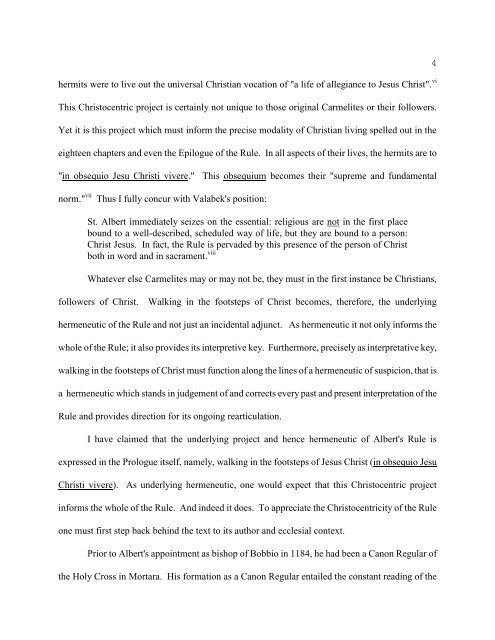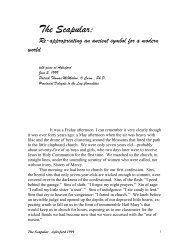Christocentrism of Charism – Buggert - CarmelStream
Christocentrism of Charism – Buggert - CarmelStream
Christocentrism of Charism – Buggert - CarmelStream
You also want an ePaper? Increase the reach of your titles
YUMPU automatically turns print PDFs into web optimized ePapers that Google loves.
hermits were to live out the universal Christian vocation <strong>of</strong> "a life <strong>of</strong> allegiance to Jesus Christ". vi<br />
This Christocentric project is certainly not unique to those original Carmelites or their followers.<br />
Yet it is this project which must inform the precise modality <strong>of</strong> Christian living spelled out in the<br />
eighteen chapters and even the Epilogue <strong>of</strong> the Rule. In all aspects <strong>of</strong> their lives, the hermits are to<br />
"in obsequio Jesu Christi vivere." This obsequium becomes their "supreme and fundamental<br />
norm." vii Thus I fully concur with Valabek's position:<br />
St. Albert immediately seizes on the essential: religious are not in the first place<br />
bound to a well-described, scheduled way <strong>of</strong> life, but they are bound to a person:<br />
Christ Jesus. In fact, the Rule is pervaded by this presence <strong>of</strong> the person <strong>of</strong> Christ<br />
both in word and in sacrament. viii<br />
Whatever else Carmelites may or may not be, they must in the first instance be Christians,<br />
followers <strong>of</strong> Christ. Walking in the footsteps <strong>of</strong> Christ becomes, therefore, the underlying<br />
hermeneutic <strong>of</strong> the Rule and not just an incidental adjunct. As hermeneutic it not only informs the<br />
whole <strong>of</strong> the Rule; it also provides its interpretive key. Furthermore, precisely as interpretative key,<br />
walking in the footsteps <strong>of</strong> Christ must function along the lines <strong>of</strong> a hermeneutic <strong>of</strong> suspicion, that is<br />
a hermeneutic which stands in judgement <strong>of</strong> and corrects every past and present interpretation <strong>of</strong> the<br />
Rule and provides direction for its ongoing rearticulation.<br />
I have claimed that the underlying project and hence hermeneutic <strong>of</strong> Albert's Rule is<br />
expressed in the Prologue itself, namely, walking in the footsteps <strong>of</strong> Jesus Christ (in obsequio Jesu<br />
Christi vivere). As underlying hermeneutic, one would expect that this Christocentric project<br />
informs the whole <strong>of</strong> the Rule. And indeed it does. To appreciate the Christocentricity <strong>of</strong> the Rule<br />
one must first step back behind the text to its author and ecclesial context.<br />
Prior to Albert's appointment as bishop <strong>of</strong> Bobbio in 1184, he had been a Canon Regular <strong>of</strong><br />
the Holy Cross in Mortara. His formation as a Canon Regular entailed the constant reading <strong>of</strong> the<br />
4



